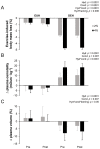Impact of Repeated Acute Exposures to Low and Moderate Exercise-Induced Hypohydration on Physiological and Subjective Responses and Endurance Performance
- PMID: 34960028
- PMCID: PMC8704556
- DOI: 10.3390/nu13124477
Impact of Repeated Acute Exposures to Low and Moderate Exercise-Induced Hypohydration on Physiological and Subjective Responses and Endurance Performance
Abstract
This study aimed to examine whether repeated exposures to low (2%) and moderate (4%) exercise-induced hypohydration may reverse the potentially deleterious effect of hypohydration on endurance performance. Using a randomized crossover protocol, ten volunteers (23 years, V˙O2max: 54 mL∙kg-1∙min-1) completed two 4-week training blocks interspersed by a 5-week washout period. During one block, participants replaced all fluid losses (EUH) while in the other they were fluid restricted (DEH). Participants completed three exercise sessions per week (walking/running, 55% V˙O2max, 40 °C): (1) 1 h while fluid restricted or drinking ad libitum, (2) until 2 and (3) 4% of body mass has been lost or replaced. During the first and the fourth week of each training block, participants completed a 12 min time-trial immediately after 2% and 4% body mass loss has been reached. Exercise duration and distance completed (14.1 ± 2.7 vs. 6.9 ± 1.5 km) during the fixed-intensity exercise bouts were greater in the 4 compared to the 2% condition (p < 0.01) with no difference between DEH and EUH. During the first week, heart rate, rectal temperature and perceived exertion were higher (p < 0.05) with DEH than EUH, and training did not change these outcomes. Exercise-induced hypohydration of 2% and 4% body mass impaired time-trial performance in a practical manner both at the start and end of the training block. In conclusion, exercise-induced hypohydration of 2% and 4% body mass impairs 12 min walking/running time-trial, and repeated exposures to these hypohydration levels cannot reverse the impairment in performance.
Keywords: exercise-induced dehydration; habituation; hypohydration; performance; repeated.
Conflict of interest statement
The authors declare no conflict of interest.
Figures




References
MeSH terms
Grants and funding
LinkOut - more resources
Full Text Sources
Medical

